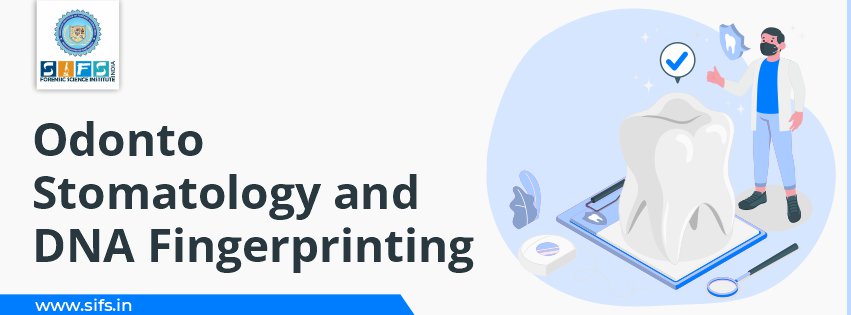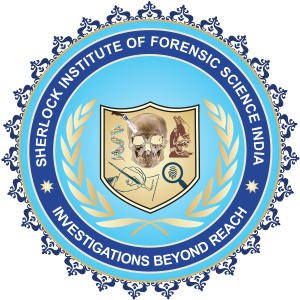- Call Us: +91 7303913002
- Email Us: education@sifs.in
Odonto-Stomatology and DNA Fingerprinting

BY SIFS India | February 02, 2025
Odonto-Stomatology and DNA Fingerprinting
Teeth are among the hardest structures of the human body as well as resistant to adverse conditions, so they can be used as an identification tool in forensic investigations.
They are also valuable sources of DNA, as other parts of the body are destroyed or degraded in mass disasters. Human lips have numerous lines and furrows in the form of wrinkles and grooves located between labial mucosa and outer skin.
The study of lip prints is also known as Cheiloscopy. These lip prints are unique, permanent and unchanged even after death.
Palatal rugae are ridges located on the anterior part of the palate extending bilaterally from the mid-palatine raphe behind the incisive papilla. The study of the uniqueness of palatal rugae is known as rugoscopy.
Tooth structures like enamel( AMELIGIN PROTEIN), dentin, cementum, pulp, and adherent tissues like bone and periodontal fibres are sources from which DNA can be obtained.
Introduction
DNA is the genetic code of most organisms including humans.
In the last few years, DNA analysing methods are applied to forensic cases for human beings' identification which is termed forensic genetics.
It is often challenging to obtain and interpret DNA from routine samples like blood in severely decomposed dead bodies recovered from incineration, immersion, trauma, mutilation and decomposition as in incidents of fire, explosion or murder.
The tooth can survive any extreme environment with minimum risk of contamination making it a valuable alternative source of DNA analysis in such cases.
Tooth structures like enamel, dentin, cementum, pulp and periodontal fibres, and alveolar bones are sources from which DNA can be obtained.
DNA can be isolated from the saliva deposited on the skin and is usually very small in bite mark cases. In the present day, several techniques were evaluated to determine the test method of collecting saliva from human skin and extracting DNA from the substrate.
Dental Characteristics such as shovelling, Double shovelling, Winging, odontoma, interruption grooves, Parastyle, Protostylid etc. are used to determine ancestry. Dental restorations also help in finding the race of the victim or a culprit.
Identification from Dental DNA
Since Teeth can resist extreme conditions, Pretty and Sweet state that teeth are an excellent source of DNA.
A routinely applied technique in forensic investigations known as the polymerase chain reaction (PCR), allows the amplification of even highly degraded DNA.
This facilitates comparison with a known biological ante mortem sample of the decedent, such as hair from a hairbrush, epithelial cells from a toothbrush or a biopsy specimen.
A major advantage of DNA analysis over conventional dental identification is that, if a decedent’s ante mortem sample is unavailable, the DNA pattern may be compared to a parent or to a sibling, thus allowing identification
Pulp: Pulp play a vital role in forensic odontology. Pulp tissues can be used for molecular analysis to determine age, sex and blood group antigen. Apart from these, the extracted DNA from pulp can be used for Personal identification.
Cementum: It is continuously deposited at the root end and seen as incremental lines. Many researchers have used cemental annulations to determine the age of adults. Cementum annulations refers to an alternating dark and light band; each pair of it represents 1 year.
Dentin: Dentin translucency is other dental physiological process that begins in the second or third decade of life and progresses with age. Age determination can be of great value in forensic odontology not only in identifying bodies but also in relation to crime.
Extraction of Dental DNA
Owing to their neuromuscular nature, pulpal tissues are considered to be the best source of DNA. Sweet and Hildebrand have advocated a method known as cryogenic grinding for extracting DNA. The major drawback of cryogenic grinding is that the tooth needs to be completely crushed
Therefore, Trivedi and co-workers have suggested a less destructive method for DNA isolation.
Their method involves drilling of the root canals, scrapping the pulp area with a notched needle, and subsequent flushing of the tissue debris. This, the authors claim, ‘retains the morphology of the tooth ‘.
Hence one may be advised to utilize multiple teeth for optimal results.
Types of DNA
Pretty and Sweet have pointed out the use of two types of DNA.
The first is called genomic or nuclear DNA.
This is located in the nucleus of the cells and is commonly used in forensic cases.
The second known as mitochondrial DNA (mtDNA) is present in the mitochondria of the cells.
While any given cell has a single nucleus, Bender and associates point out that a major advantage of mt DNA is that each cell has a high copy number of mtDNA e.g. epithelial cellscontain 5000 mtDNA molecules.
Hence mtDNA can substitute in cases where nuclear DNA is unavailable. Also, mtDNA is exclusively inherited from the mother.
Moreover due to their exclusive maternal inheritance, they can be used to establish identity in cases where is a gap of several generations.
Rugoscopy: Palate a Tool to Forensic Identification
Palatal rugae are ridges located on the anterior part of the palate extending bilaterally from the mid-palatine raphe behind the incisive papilla. It is useful in both dentulous and edentulous subjects and is unique for every individual.
These rugae are well protected by lips, cheek, alveolus, teeth and tongue during high-impact trauma, assaults, mass disasters and fire accidents, Rugae is compared with the previous photographs, dental cast, digital impression and cone beam computed tomography (CBCT) from the dental records using software programs.
Cheiloscopy: Lip a Tool to Forensic Identification
The human lip has numerous lines and furrows in the form of wrinkles and grooves located between the labial mucosa and outer skin.
Impression of these wrinkles and grooves with moisture over any object will lead to form lip prints. It is obtained at the crime scene from glasses, cups, cigarettes, windows, doors and clothes.
The study of lip prints is also known as Cheiloscopy. These lip prints are genetic, once developed at the six months of intrauterine life. It is unique, permanent and unchangeable even after death.
Bite Marks as Evidence in Forensic Investigations
Human bite marks analysis is the most demanding and complicated part of forensic dentistry, involving the identification of assailants by comparing records of their dentition with records of their bite marks left on a victim.
The most important evidence from bite mark victims is photography. It is performed by the forensic dentist or under the odonatologist’s direction to ensure accurate and complete documentation.
Berlitz et al (2000) reported a case of murder with a bite mark in a piece of cheese which was recorded. The pattern associated with a comparison between the impression and a study model of the suspect was able to identify the predator.
McDonald’s classification of bite marks is the most cited
Tooth Pressure Marks: These are caused by incisal edges of the anterior teeth. They are stable and subject to minimal distortion.
Tongue Pressure Marks: Because of tongue pressure, impression of the palatal surface of the teeth, cingulum, or palatal rugae may be produced. This causes distortion of marks
Tooth Scrape Marks: These are produced because of irregularities in teeth due to fractures restorations, etc.
Complex Marks: These are a combination of the above types of marks. The shape depends on amount of tissue taken into a mouth.
Conclusion
Forensic dentistry plays a major role in the identification of those individuals who cannot be identified visually or by other means.
Greater knowledge and awareness of forensic odontology among dental professionals would be required in the growing field of medicine.
Teeth should be considered for DNA analysis as they are rich in quality DNA which can be utilized in all forensic investigations.
When other means of traditional identification become impossible following mass calamities or fire explosions, teeth provide a rich source of DNA as they have a high chemical as well as physical resistance.
Note - The figures and images used in this blog are only for educational purposes.

